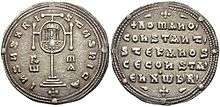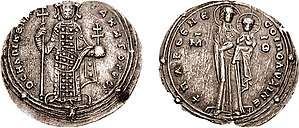Miliaresion
The miliaresion (Greek: μιλιαρήσιον, from Latin: miliarensis), was a name used for a number of Byzantine silver coins. In its most specific sense, it refers to a type of silver coin struck in the 8th–11th centuries.

History
Originally, the name was given to a series of silver coins issued in the 4th century that were struck 72 to the pound and were the equivalent of 1,000 nummi. Thereafter and until the 7th century, the Byzantines did not use silver coins. In the 7th century, miliaresion was the name given to the hexagram-type coins, and from circa 720 on for a new type, broader and thinner than the hexagram, instituted by the Byzantine emperor Leo III the Isaurian (r. 717–741).[1][2]
This latter type, for which the term miliaresion is usually preserved among numismatists, were apparently struck 144 to the pound, with an initial weight of circa 2.27 grams, although in the Macedonian period that increased to 3.03 grams (i.e. 108 coins to the pound).[1] In the first century of its issue, it appears to have been issued solely as a ceremonial coin on the occasion of the appointment of a co-emperor, and hence always features the names of two Byzantine emperors. Only from the reign of Emperor Theophilos (r. 829–842) did the coin become regular issue, struck throughout an emperor's reign.[3] The coins were inspired by the contemporary silver Islamic dirham, and in common with it (and unlike the Byzantine Empire's gold and copper coinage, or the earlier hexagram) featured initially no human representations, sporting instead the names and titles of the emperor or emperors on the reverse and a cross on steps on the obverse. In the 10th century, Emperor Alexander (r. 912–913) introduced a bust of Christ on the obverse, and Romanos I (r. 920–944) added an imperial bust to the center of the cross. This process culminated in the 11th century, when images of emperors, Christ, and the Virgin Mary began to appear.[4]
In the 11th century, 2⁄3 and 1⁄3 fractions of the miliaresion also began to be minted, but the military and financial collapse of the 1070s–1080s affected its quality.[5] It was discontinued after 1092, except as a money of account equal to 1⁄12 of the nomisma. Under the Komnenian emperors, it was initially replaced by a very low-grade billon trachy coin, initially worth a quarter of a miliaresion but later much devalued. The miliaresion was essentially revived in the form of the basilikon issued from circa 1300 onwards.[1][6]
The name also passed into Western European languages, where milliarès was used for various kinds of Muslim silver coins.[1]
Gallery
 Miliaresion struck by Romanos I Lekapenos (r. 920–944), showing his bust on a cross (obverse) and listing the names of himself and his co-emperors, Constantine VII, Stephen and Constantine (reverse).
Miliaresion struck by Romanos I Lekapenos (r. 920–944), showing his bust on a cross (obverse) and listing the names of himself and his co-emperors, Constantine VII, Stephen and Constantine (reverse). Miliaresion struck by Romanos III (r. 1028–1034), featuring the Virgin with the infant Christ on the obverse and the standing emperor on the reverse.
Miliaresion struck by Romanos III (r. 1028–1034), featuring the Virgin with the infant Christ on the obverse and the standing emperor on the reverse.
References
- Kazhdan 1991, p. 1373.
- Grierson 1999, p. 13.
- Grierson 1999, p. 14.
- Grierson 1999, pp. 14–15.
- Grierson 1999, pp. 15, 44.
- Grierson 1999, pp. 15–16.
Sources
- Grierson, Philip (1999). Byzantine Coinage (PDF). Washington, DC: Dumbarton Oaks. ISBN 978-0-88402-274-9. Archived from the original (PDF) on 2010-06-13.CS1 maint: ref=harv (link)
- Kazhdan, Alexander, ed. (1991). The Oxford Dictionary of Byzantium. New York and Oxford: Oxford University Press. ISBN 978-0-19-504652-6.CS1 maint: ref=harv (link)
Further reading
- Grierson, Philip (1982). Byzantine Coins. London: Methuen. ISBN 978-0-416-71360-2.
- Hendy, Michael F. (1985). Studies in the Byzantine Monetary Economy c. 300–1450. Cambridge: Cambridge University Press. ISBN 0-521-24715-2.CS1 maint: ref=harv (link)
- Lauritzen, Frederick (2009). "The Miliaresion Poet: The Dactylic Inscription on a Silver Coin of Romanos III Argyros". Byzantion. 79: 231–240. ISSN 0378-2506.
External links
![]()